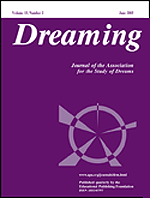 Here are excerpts from notes I took during the recent conference of the International Association for the Study of Dreams, held in Berkeley, California, June 22-26. In parentheses I’ve put the names of the people who were presenting or commenting at the time.
Here are excerpts from notes I took during the recent conference of the International Association for the Study of Dreams, held in Berkeley, California, June 22-26. In parentheses I’ve put the names of the people who were presenting or commenting at the time.
Jung’s focus on the number 4 is “dangerous” and promises a “seductive wholeness.” (John Beebe)
In electrophysiological terms, as measured by the EEG, lucid dreaming can be described as meditation in sleep. (Jim Pagel)
A challenge for lucid dreamers: How to distinguish a failed lucidity technique from a sage warning from the unconscious. (Jeremy Taylor)
The pioneering French filmmaker George Meliere drew upon the fantastically creative, compelling illusions of dream experience to create a tradition of visionary cinema that we see today in “The Matrix” and “Eternal Sunshine of the Spotless Mind.” (Bernard Welt)
In a sample of 170 German school children, those who talk with their parents, siblings, and friends about dreams tend to have higher dream recall, suggesting a positive relationship between dream socialization and recall. (Michael Schredl)
People who are high dream recallers seem to have more activity in the brain’s tempero-parietal junction and medial prefrontal cortex, in both waking and sleep conditions. These brain areas have been associated in waking with mental imagery and mind attributions (theory of mind), respectively. (Jean-Baptiste Eichenlaub, et al.)
Sleep laboratory researchers are perfecting a method of awakening a person several times during the night at precise moments in the sleep cycle in order to induce an experience of sleep paralysis. (Elizaveta Solomonova)
Neuroscientists are experimenting with the use of transcranial direct current stimulation to directly affect the brain activity underlying dream experiences. (Katja Valli)
Reflective awareness in dreaming can give humans an adaptive edge because in dreams we have the ability to anticipate, explore, and practice possible selves and possible worlds. This ability can be cultivated through disciplined intentional mental practice. We can change our brain anatomy simply by using our imaginations. (Tracey Kahan, quoting Norman Doidge in the last sentence)
The “Inception” app is “worth a free download.” (David Kahn)
The mantra of the quantified self: If you track it, it improves. (Ryan Hurd)
In dream education with adolescents and young adults, the most relevant aspect of dreaming to their waking lives may be relational skills and emotional intelligence, helping them better navigate the complex currents of friendship, romance, and family life. (Phil King and Bernard Welt)

